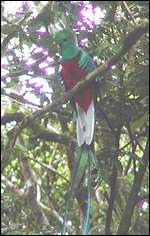Ronni heard it first: the softly insistent, slightly descendant keloo-keloo of the quetzal, strobing from the cloud forest around us. We were hiking the five-mile Sendero de los Quetzales (“Path of the Quetzals”), a trail that winds through the 35,390 lush acres of Panama's Volcán Barú National Park in UNESCO's La Amistad Biosphere Reserve—one of the best places in the world to see the rare and visually spectacular bird.
Panama, conservation
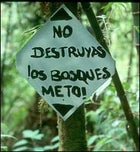 Don't destroy the forests!
Don't destroy the forests!Panama, conservation
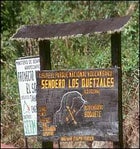 Environmental battleground: The Sendero de los Quetzales
Environmental battleground: The Sendero de los QuetzalesPanama, conservation
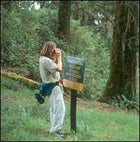 Looking for quetzals on the Sendero
Looking for quetzals on the SenderoPanama, quetzal, conservation
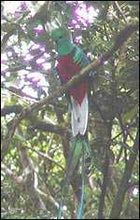 A resplendent quetzal at rest
A resplendent quetzal at restAs we stalked through the foliage the quetzal revealed itself: a male whose crimson breast radiated from a tuxedo of aquamarine, his brilliant viridian tail feathers draped two feet behind. Tilting his gold-crested head, the bird listened for a female response to his mating call—a call that, sadly, may prove to be his last if Panama's presidential administration has its way. Within months of our visit this very footpath would become an environmental battleground, with activists and campesinos marching against government-deployed bulldozers; each side determined to decide the fate of Volcán Barú and its quetzal population.
In December 2002, Panamanian president Mireya Moscoso announced plans to pave the Path of the Quetzals, which winds through Volcán Barú between the agricultural center of Cerro Punta and the mountain hamlet of Boquete. The new road would bring commerce and traffic to these isolated enclaves in Panama's Chiriqui Highlands, where an estimated 300 to 400 quetzal breeding pairs hold out against their chief enemy, forest fragmentation.
The quetzal has been called “the most spectacular bird in the New World” by renowned ornithologist Roger Peterson, yet today it's listed as Appendix I in the Convention on International Trade in Endangered Species (CITES), meaning that the species is threatened with extinction. But the quetzal is not just a bird in danger; it's an esteemed animal with a past rooted in Mayan and Aztec culture.
Quetzalcoatl, a central figure in Mayan mythology, is depicted as a hybrid of a quetzal and a serpent. In ancient times, only royalty could wear quetzal feathers; possession of the shimmering plumage (valued as much as gold) by commoners was a crime punishable by death. More recently, indigenous peoples in Central America, believing the quetzal unable to survive in captivity, have interpreted it as a symbol of freedom.
��
By paving the Sendero de los Quetzales, the Moscoso administration aims to connect Boquete with the rich farming region around Cerro Punta, where over half of Panama's vegetables are grown. Administration Press and Information Adviser Mario Rognoni says building a road will make the area more accessible to tourists via the Inter-American Highway (turning a one-hour drive around Volcán Barú into a ten-minute straight shot through the park), and would shorten the distance between highland village communities to the north.
So what's the administration's rationale for selecting a route that slices through the biosphere reserve? The Sendero de los Quetzales traverses a less rugged landscape than alternative routes, making it the least expensive construction option. “All residents want a road built,” says Rognoni, “The controversy arises in the route selected, not the road itself. Even those who favor the alternate route are interested in the road.”
But opponents of the project say that a paved byway through the park would allow predators easy access to quetzal nests, destroy seed trees the quetzals depend upon for food, and facilitate poaching, illegal logging, and other habitat-destroying activities. Over the past months, a broad coalition of activists and concerned citizens has launched a campaign to stop the road, marking the rare appearance of an environmental issue on center stage in Panamanian affairs. Lider Sucre, executive director of ANCON, Panama's foremost environmental advocacy group, said, “Rarely have we seen such a level of activity from such a broad spectrum of entities. [In Panama] it's very rare that an environmental issue causes so much activism in a rural area. This has really been a watershed crusade.”
Despite public opposition, Moscoso has rejected counter-proposals to site the road outside the critical quetzal habitat. In December 2002, facing organized demonstrations, Moscoso declared the road of “notorious urgency”—a designation intended for disaster relief in cases of hurricanes, floods or other natural catastrophes—and awarded the $4.6 million construction contract to a firm of her choosing, avoiding review and public comment processes, and subsequently triggering a lawsuit from ANCON. In an effort to ensure that the project would be pushed through, the Moscoso administration then introduced an amendment changing the regulations that govern Volcán Barú National Park—the first-ever alteration to the park's charter—and by executive fiat legalized all previously proscribed activities associated with the road's construction.
��
Moscoso's zeal spurred allegations by the mayor of Panama City that she was primarily interested in boosting property values on land she owned along the route. She denied the charges and threatened to sue him for criminal defamation, but a subsequent investigation by the daily newspaper El Panama America revealed that Moscoso served as president of a holding company that owned 2,291 acres near the site of the proposed road. A nephew of Moscoso's late husband, the former president, hastily produced an unrecorded deed indicating that her company had sold three-quarters of the land in 1985—to another company comprised of her family members, some of whom are high-ranking officials in her administration.
Speaking to La Prensa, the nephew (also an administration official) indicated that the land had been “forgotten” by the family. Published reports suggest that Moscoso may retain ownership of a quarter interest in the property, but her administration denies that she has ever owned land in the area, except for a coffee plantation in Boquete.
The administration also claims that the anti-road activists are the ones with ulterior motives. When asked whether Moscoso thinks the road is unpopular, spokesperson Rognoni replied, “No. The opposition has been initiated by those who favored the alternate route, whose land and properties would have benefited from the road in their proposed route, and they in turn have motivated political adversaries from outside the area to protest the road.”
At the root of the presidential soap opera is the fact that Panamanian politics are known for corruption—so much so that the term juega vivo (meaning “play smart,” but nuanced with a sense of unethical, self-interested behavior) was coined to describe the phenomenon. Since taking power in 1999, Moscoso's administration has suffered from scandals and resignations. And according to the San Antonio Express-News, the president herself has been accused of stealing from the public treasury: Over the past few years a fleet of presidential cars has gone unaccounted for, a taxpayer-funded beach house ended up in her brother's name, and $40,000 mysteriously turned up in the freezer of one of her assistants.
��
The president fares poorly in public opinion polls and, considering that a Panamanian president can't serve two terms in a row, many of her countrymen have expressed relief that she'll be obliged to step down from her post during the May 2 elections.
The good news for environmentalists is that all of the major presidential candidates in the upcoming election oppose the “Ecological Road” (including the candidate that Moscoso supports), and that if Moscoso is unable to push the project through before she leaves office, it's unlikely ever to be completed. But heavy construction equipment now sits at both ends of the proposed corridor, even as demonstrations increase in size and are met with growing force from police.
On December 11, ANCON filed its third lawsuit in connection with the road, this one claiming Moscoso's alterations to Volcán Barú's charter were illegal and violated international treaties establishing the park. But bribery scandals involving legislators who allegedly accepted millions of dollars to confirm Supreme Court justices—and Moscoso's close personal relationship with the presiding magistrate in these suits—have cast doubts on any notion of a fair hearing.
In the meantime, UNESCO has stated that it does not support the road, and Conservation International, The Nature Conservancy, and the IUCN have all condemned the project. The World Bank, too, suggested it would not lend money to support the project and urged the evaluation of alternative routes.
In mid-February, the director of Panama's environmental department rejected the proposed road in an ecological-impact statement, and then immediately resigned (allegedly under pressure from Moscoso). A new director was then appointed, but he quit after just two weeks on the job, leaving the position in its current state—vacant. “It doesn't get any dirtier than this,” ANCON's Lider Sucre commented about the situation.
But winter in Panama is drawing to a close, and the nasty, April-through-November rainy season promises to bring extremely muddy conditions that will make building the road nearly impossible. With Moscoso's term ending in September, environmentalists are crossing their fingers that time will run out on the “Ecological Road.” Right now, the future hangs in the balance for the quetzals—who have no idea how to play smart—but with any luck, Mother Nature just might give the birds the last laugh.
��


